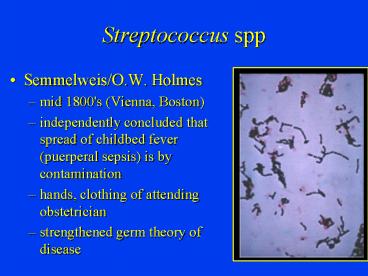Streptococcus spp - PowerPoint PPT Presentation
1 / 18
Title:
Streptococcus spp
Description:
hands, clothing of attending obstetrician. strengthened germ theory of disease. Streptococcus spp ... varies with time, geography. Pneumolysin: alveolar ... – PowerPoint PPT presentation
Number of Views:373
Avg rating:3.0/5.0
Title: Streptococcus spp
1
Streptococcus spp
- Semmelweis/O.W. Holmes
- mid 1800's (Vienna, Boston)
- independently concluded that spread of childbed
fever (puerperal sepsis) is by contamination - hands, clothing of attending obstetrician
- strengthened germ theory of disease
2
Streptococcus spp
- Gram positive, facultatively-anaerobic
- Catalase negative, no spores, nonmotile
- Cell division single plane gt chains
- Lancefield Grouping
- species-specific CHO cell wall antigens
- groups designated A-H, K-V
- some not groupable
3
Bilobar Pneumonia
- Most important cause of community-acquired
pneumonia in humans - carrier rate 40-70
- Broad host range (rodents, monkeys, dogs, horses)
- Multidrug resistance increasingly prevalent
- Major effort on vaccine development
4
Virulence
- Polysaccharide capsule resistance to
phagocytosis - 80 types, CHO antigen
- nonencapsulated strains avirulent
- occurrence varies with time, geography
- Pneumolysin alveolar necrosis
- O2-labile hemolysin
- slows cilia, reduces clearance
- Neuraminidase decrease mucus viscosity, expose
receptors
5
Immunity
- Type-specific anticapsular antibodies
- opsonizing, facilitate phagocytosis
- 70 of untreated cases recover
- Recurrence due to infection with different types
6
Streptococcus suisGroups D,R,S,T
- Single genetic type
- Tonsil carrier rate up to 100
- Piglets infected at birth (oral, respiratory)
- Encephalitis, meningitis, arthritis, septicemia,
abortion, endocarditis in swine
7
Streptococcus agalactiaeGroup B
- Chronic bovine mastitis
- promoted by milking machines
- slowly progressing inflammation, fibrosis
- fibrin plugs in smaller milk ducts loss of
milk-producing capacity (agalactia) - Neonatal meningitis in humans
- early onset septicemia ( 15 of all neonatal
septicemias) - late onset purulent meningitis (average 4.8
weeks after birth) - 5 - 10 of pregnant women are reproductive tract
carriers
8
Streptococcus equi ss equiGroup C
- Upper respiratory tract infection (strangles) in
horses - abscesses in LN develop, enlarge
- pressure on airway causes respiratory difficulty
(strangles) - metastasis to lungs, abdomen, brain
9
Virulence
- Nonantigenic hyaluronic acid capsule
- Hyaluronidase
- Streptolysin O (SLO)
- Streptokinase
- IgG Fc-receptor proteins
- Antiphagocytic M protein varying amounts of M
protein yield variations in virulence - bind fibrinogen, complement control factor H
- masks bacterial C3b-binding sites
- Opsonizing antibodies formed against N-terminal
epitopes
10
Streptococcus equi ss zooepidemicus
- Horses
- wound infections, joint ill, lymphatic abscesses
- pneumonia in foals
- mare reproductive tract infections
- Bovine, caprine mastitis
- Lambs wound infections, pneumonia, septicemia
- Pups, chickens, rodents
- Human infections via contaminated dairy products
11
Streptococcus canis
- Canine genital, skin, wound infections
- Canine streptococcal shock emerging problem in
dogs - septicemia, toxic shock fatal
- necrotizing fasciitis alone survive with radical
treatment - Feline abscesses, metritis, mastitis, kitten
septicemia
12
Streptococcus pyogenesGroup A
- Pyoderma, lymphadenitis, erysipelas (humans)
- Wounds cellulitis, puerperal fever
- Septic sore throat, scarlet fever
- acute inflammation
- pharyngitis
- pus patches (fibrin, PMNs, mucosal fragments)
13
Streptococcus pyogenesSequelae to strep throat
- Heart valve damage (rheumatic heart disease)
- lt 3 of people with strep throat, weeks after
sore throat - migrating arthritis heart valve damage (50),
some fatal - recurrences common, lifelong penicillin therapy
- shared antigen M protein, cardiac myosin
- attack by T cells, Ab inflammation, valve damage
14
Streptococcus pyogenesSequelae to strep throat
- Glomemlonephritis
- symptoms 10 days after 1 infection edema
- decreased urination, hematuria, hypertension
- AgAb complexes accumulate, C activated
- provoke inflammatory response, interferes with
normal kidney function - young children self-limiting
- teenagers/adults rare permanent kidney damage,
chronic glomerulonephritis
15
Streptococcus pyogenesScarlet Fever
- Childhood disease, diffuse rash, fever
- Late 1800s highly virulent form, high death rate
- 1900 - 1950 milder form most common
- 1950 - 1980 virtually disappeared
- 1980 appearance of streptococcal toxic
shock-like syndrome (TSLS after recognition of
staphylococcal TSS) - began as skin or wound infection, developed into
septicemia - death rate sometimes over 30 ( 2 for TSS),
some disabled, some healthy
16
Streptococcus pyogenesNecrotizing Fasciitis
- Invasive, nonTSLS disease
- necrotizing fasciitis (flesh-eating bacteria)
- rapid development of shock, multiple organ system
failure - high fatality rate
17
Virulence
- Capsule 100X virulence reduction with loss of
capsule - C5a peptidase (cleaves C5a)
- Streptokinase dissolves fibrin clots
- M protein 80 serotypes
- antiphagocytic degradation of C3b
- prevents opsonization
- mutants without M protein phagocytosed
18
Virulence Factors
- Streptolysin O thiol-activated toxin (Groups
A,C,G) - damages membranes RBCs, myocardial cells, PMNs
- role in intracellular survival
- Erythrogenic toxins rash of scarlet fever
- pyrogenicity, lethal shock
- 105-fold increased sensitivity to endotoxin
- Pyrogenic exotoxin A
- contributes to streptococcal TSLS
- stimulates cytokine production by T cells
- endothelial cell damage, hypotensive shock,
ischemia-based necrosis






























